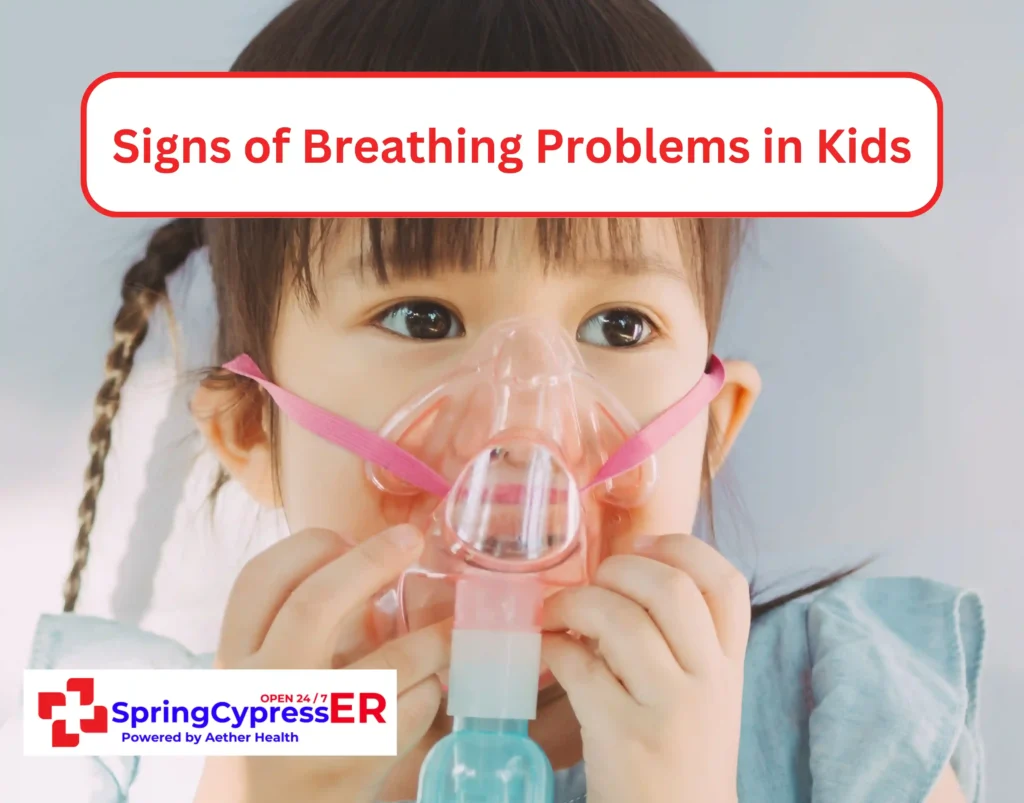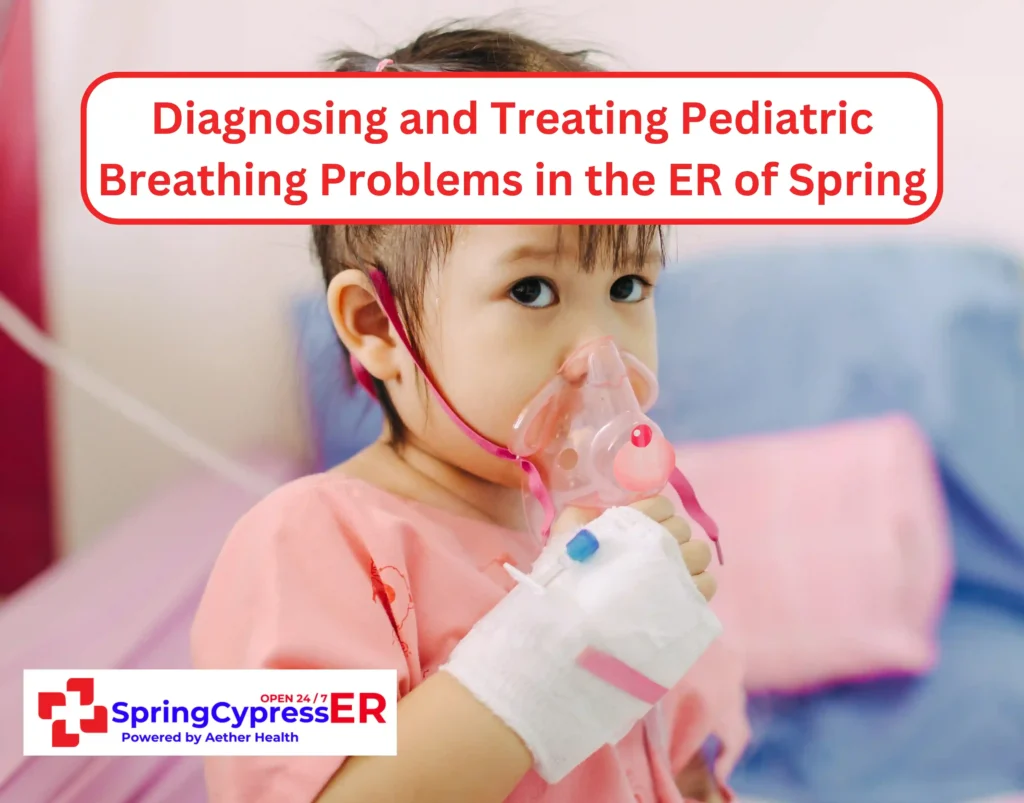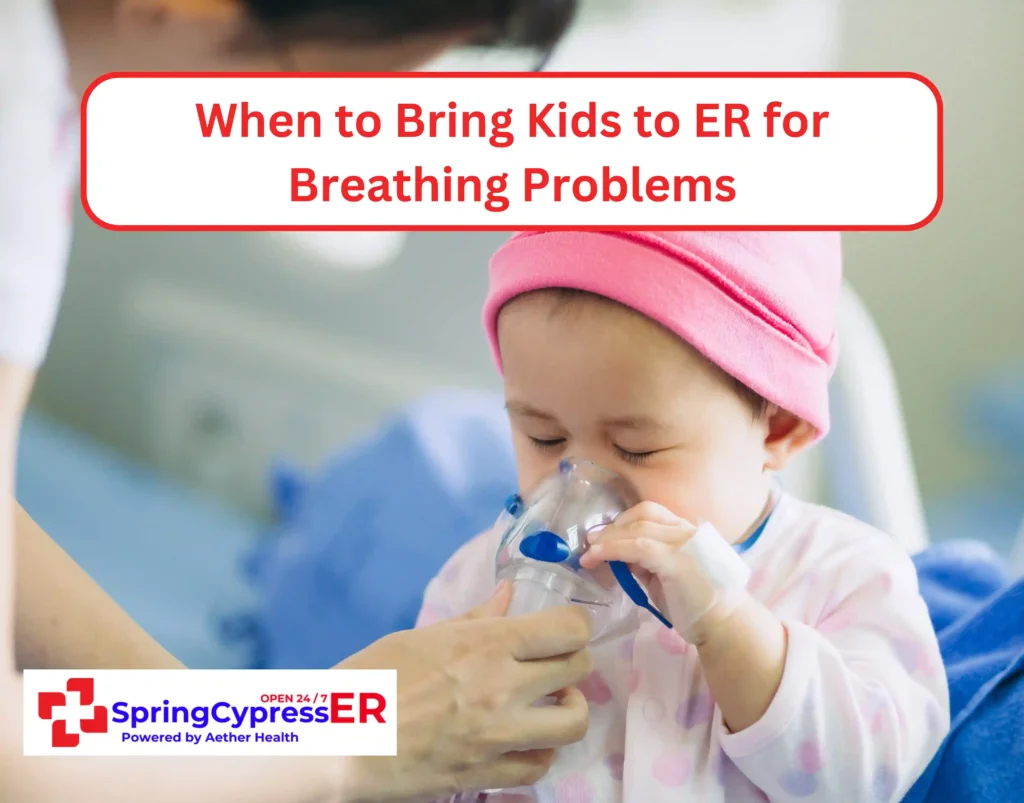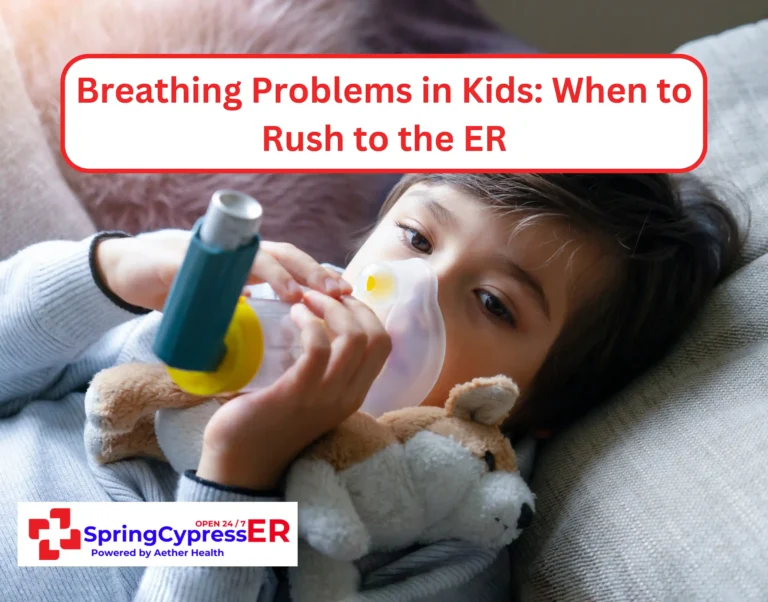Breathing problems in kids can strike without warning and turn ordinary moments into medical emergencies. Those frightening seconds feel like hours, leaving you helpless and unsure of what to do next.
From sudden asthma attacks and severe allergic reactions to dangerous respiratory infections, breathing difficulties in children demand swift recognition and decisive action. Understanding when to seek emergency care for breathing not only provides peace of mind but can also protect your child’s life.
Let’s recognize the emergency breathing symptoms so that you can take immediate and potentially life-saving action during these scary situations.
Signs of Breathing Problems in Kids

Identifying the signs of respiratory issues in children is the first step in taking appropriate measures. Watch carefully for these critical signs that indicates that your child may be having trouble breathing:
- Rapid Breathing: If your child’s breathing becomes unusually fast for their age, often accompanied by visible chest movements. This could signal their body’s struggle to get enough oxygen.
- Wheezing: Listen for a high-pitched whistling sound when your child breathes out, or a loud, harsh sound (stridor) when breathing in. These noises often indicate narrowed or blocked airways.
- Visible Breathing Effort: Check for skin pulling in between the ribs or around the neck during breaths, and nostrils widening with each inhale. These signs show your child is working too hard to breathe.
- Blue or Pale Skin: Pay attention if your child’s lips or fingertips turn bluish (cyanosis). This condition suggests their body isn’t getting enough oxygen.
- Exhaustion or Lethargy: Extreme tiredness or difficulty staying awake due to ongoing effort to breathe.
- Difficulty Talking or Crying: Watch if your child struggles to form complete sentences or cry normally. Difficulty with these basic functions often signals serious breathing problems in kids.
Remember, breathing problems can escalate rapidly. So if you notice any of these signs, especially in combination, don’t wait to seek emergency care.
Common Causes of Breathing Problems in Kids
Identifying the reasons behind your kid’s breathing difficulties can help you respond appropriately and know when to seek emergency breathing treatment. Here are the most common causes:
1. Asthma
Asthma is a long-term condition that causes inflammation and constriction of the airways, resulting in wheezing, coughing, and breathing challenges. Common triggers of asthma include allergens, cold air, physical activity, and respiratory illnesses.
2. Croup
Croup is a viral illness that inflames the upper airways, leading to a distinctive “barking” cough and harsh breathing sound. Symptoms often worsen during the night, making kids’ breathing problems at night a significant concern.
3. Bronchiolitis
Bronchiolitis, which is caused by respiratory syncytial virus (RSV), is prevalent in infants and young children. Unlike bronchitis, which affects the bronchi or large airways, bronchiolitis affects the bronchioles or smaller airways in the lung. Both conditions share common symptoms including wheezing, rapid breathing, and a persistent cough that worsen over several days.
4. Pneumonia
Pneumonia is a lung infection brought about by bacteria or viruses. It causes fever, cough, and labored breathing. Children may complain of chest pain and show signs of extreme fatigue.
5. Allergic Reactions
Severe allergic responses (anaphylaxis) can cause severe breathing problems as airways swell. Common triggers include certain foods, insect stings, and medications. These reactions require immediate emergency care.
6. Airway Obstructions
Young children often inhale small items like toys or food pieces, which can obstruct the airway and result in sudden breathing emergencies. Always supervise young children during meals and playtime.
7. Sleep Apnea
Obstructive sleep apnea leads to kids breathing problems at night due to partial or full airway blockages during sleep. Symptoms include snoring, restless sleeping, and breathing pauses.
8. Upper Respiratory Infections
Common colds and flu can cause nasal blockage and airway swelling, making it tougher for children to breathe, particularly when lying down. While usually manageable at home, watch for signs of worsening breathing difficulty.
9. Environmental Factors
Exposure to smoke, pollution, or strong odors can irritate your child’s respiratory system and contribute to breathing issues.
10. Birth-Related Conditions
Some children have structural or functional breathing challenges present from birth. These require ongoing medical management and close monitoring for complications.
Diagnosing and Treating Pediatric Breathing Problems in the ER of Spring

When you arrive to treat breathing difficulties in Spring Cypress ER, our experienced medical team evaluates your child’s situation using a variety of methods and instruments:
Initial Assessment
Our healthcare providers begin with a rapid evaluation, checking your child’s breathing rate, effort, and overall condition. We look for key signs like chest movements, skin color, and signs of distress while making your child as comfortable as possible.
Diagnostic Tools and Tests in Our ER
Our emergency room in Spring features a full services laboratory to address the diverse needs of our patients. Our specialized diagnostic tools:
- Pulse oximetry to measure blood oxygen levels
- Imaging tools including chest x-rays to check for infections or obstructions
- Blood tests to identify underlying causes
- Breathing tests to measure lung function
- Rapid testing for infections when needed
Emergency Treatments
Based on the diagnosis, we provide immediate interventions including:
- Quick-relief breathing medications delivered through nebulizers or inhalers
- Oxygen therapy through special masks or nasal tubes when needed
- Steroid medications to reduce airway inflammation
- Emergency procedures to remove foreign objects if present
- IV fluids and antibiotics for bacterial infections
- Emergency allergy medications
Our emergency department is fully equipped to diagnose and treat pediatric breathing emergencies, from mild respiratory distress to severe breathing difficulties requiring immediate intervention. We’ll keep you informed every step of the way and provide clear instructions for follow-up care.
When to Bring Kids to ER for Breathing Problems

Parents often wonder when to bring kids to ER breathing problems. Knowing when to seek emergency care can be critical for your child’s health. Here are clear guidelines to help you make this vital decision:
Severe Symptoms Requiring Immediate ER Care
- Blue or Pale Skin: Indicates dangerously low oxygen levels
- Severe Retractions: Noticeable sinking of the skin around the ribs and neck
- Inability to Speak or Cry: Suggests significant airway obstruction
- Stridor: A loud, high-pitched noise during breathing
- Unresponsiveness or Extreme Fatigue: Difficulty staying awake due to lack of oxygen
- Failed Treatment Response: Rescue inhalers or medications aren’t helping
- Choking Episodes: Sudden breathing difficulty after eating or playing with small objects
Nighttime Breathing Difficulties
Kids breathing problems at night may intensify due to lying flat or cooler air temperatures. Seek emergency help if:
- Your child’s breathing becomes notably loud or labored during sleep
- They wake up gasping or struggling for breath
- Breathing difficulties persist even after trying upright positions
- Using a humidifier or other home remedies doesn’t improve symptoms
Trust your instincts. If you’re seriously concerned about your child’s breathing, it’s better to seek emergency pediatric care than wait and watch. Our emergency team is equipped to evaluate and treat respiratory emergencies 24/7.
Immediate Actions to Take Before Going to the ER
While preparing for your trip to the ER, these crucial steps can help support your child’s breathing:
- Keep Your Child Relaxed: Stress can worsen breathing issues. Speak in calming tones and embrace your child if they seem upset.
- Positioning: Help your child sit upright or in a comfortable position that keeps their airways open.
- Humidified Air: Use a cool-mist humidifier or allow your child to inhale steam from a heated shower.
- Administer Medications: If your child suffers from asthma, provide their prescribed rescue inhaler according to instructions. You can also relieve asthma without inhaler by sitting upright, taking caffeinated beverages, and staying calm.
- Look for Obstructions: Check their mouth for any foreign objects if choking is a concern.
Take a moment to gather current medications and briefly note when symptoms started, what makes them worse, and any recent illnesses or potential triggers. This information helps our emergency team provide faster and more targeted care upon arrival.
Final Thoughts
Breathing problems in kids can be a frightening and overwhelming experience for parents. Whether it’s difficulty catching their breath, noisy breathing, or persistent coughing, understanding the potential causes and knowing when to act is essential for ensuring your child’s safety. Common triggers like respiratory infections, asthma, or allergies may worsen at certain times, with kids’ breathing problems at night being particularly concerning.
If you’re unsure what is causing kids to have problems breathe, observe symptoms like rapid breathing, chest retractions, or a bluish tint around the lips. These may signal a severe condition requiring immediate medical attention.
At the ER of Spring in Texas, our facility is equipped to handle all sorts of respiratory emergencies. With on-site testing for RSV, strep throat, COVID, and other potential causes of breathing issues, we ensure prompt and comprehensive care. Our doors are open 24/7, and our compassionate team is ready to help your child breathe easier.
Get Emergency Care for Breathing Problems
FAQs
When should I worry about my child’s breathing fast?
You should worry if your child is breathing fast along with other symptoms like chest retractions, flaring nostrils, bluish lips, wheezing, or difficulty speaking. Seek medical attention immediately if these signs appear.
Do kids breathe faster when sleeping?
Kids often breathe faster while sleeping, especially infants and toddlers, due to their smaller lungs and higher metabolic rate. However, consistently rapid or labored breathing during sleep may indicate a problem and should be evaluated by a doctor.
What is the first aid for difficulty breathing?
For difficulty breathing, stay calm, help the person sit up, and loosen tight clothing. If symptoms worsen, seek emergency medical help immediately.




